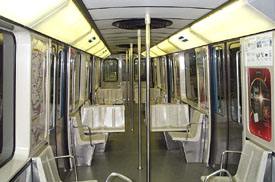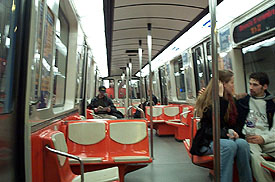- WHAT KIND OF TRAINS ARE USED IN THE METRO?
There are two kinds of trains used in the metro. The type used on the green line is called an MR-63 or Vickers (right, at top). They were built in 1963 but have been completely refurbished. Another type, the MR-73 (bottom), built in 1973, is used on the orange, yellow, and blue lines. Both types are automatically piloted but can be switched to manual control if necessary.
TOP OF THIS PAGE | FAQ CONTENTS
- HOW MANY TRAINS SERVE THE METRO?
The STM owns 336 MR-63 cars and 423 MR-73 cars, for a total of 759 cars.
TOP OF THIS PAGE | FAQ CONTENTS
- WHY ARE THE TRAINS ON THE GREEN LINE DIFFERENT FROM ON THE OTHER LINES?
The trains used on the green line are the older MR-63 cars, rather than the MR-73 cars used on the other lines. Although the different cars and tracks are compatible (indeed, MR-63s operated on the other lines until MR-73s were delivered), they are separated in this way because the MR-63 cars are serviced at the Honoré-Beaugrand garages and the MR-73 cars at the Youville garages near metro Crémazie.
TOP OF THIS PAGE | FAQ CONTENTS
- HOW LARGE ARE THE TRAINS?
A metro train can be put together with one, two, or three sections, each section composed of a trailer surrounded by two motor cars. A train made up of three sections is the same length as the platforms in each metro station - 152,4 metres (exactly 500 feet).
Cars are 2,5 metres in width; this is a narrow gauge compared to other metro systems, and restricts the number of passengers, but it allows the construction of single tunnels 7,1 metres in width, rather than the double tunnels that a larger gauge would have required.
A full 9-car train weighs 325 tonnes, can hold up to 1260 passengers, including 360 seated (as many as 15 buses), and has 36 double doors on each side.
TOP OF THIS PAGE | FAQ CONTENTS
- WHAT IS THE MAXIMUM SPEED OF A METRO TRAIN? HOW DO TRAINS BRAKE?
The maximum speed of a metro train is 72 km/h. Braking on the MR-63 cars is rheostatic, and on the MR-73 cars is dynamic.
TOP OF THIS PAGE | FAQ CONTENTS
- WHERE ARE THE TRAINS HOUSED AND REPAIRED?
When the metro is closed, trains are stored in large garages at metro Angrignon, Henri-Bourassa, and Honoré-Beaugrand, as well as in the switching tracks beyond each terminus station. Repairs are carried out on MR-63 trains at the Honoré-Beaugrand garage, and on MR-73 trains at the Youville depot on the connecting tracks between metro Parc and Sauvé. This last is the only place in the system where trains circulate above-ground, as it is where metro cars were delivered when purchased.
For more information on auxiliary installations, please see the section on Other Installations.
TOP OF THIS PAGE | FAQ CONTENTS
- WHAT IS THAT THREE-NOTE SOUND I HEAR WHEN A METRO TRAIN STARTS UP?
The three-note sound (there may be more notes during a slower startup) that is produced by the MR-73 trains (orange, yellow, and blue lines) is the sound of a piece of equipment called a peak chopper. It is used to power up the motors on the train in stages, to prevent a power surge.
Coincidentally, the three notes are the same as the first three notes as Aaron Copland's Fanfare for the Common Man, one of the musical themes for Expo '67.
TOP OF THIS PAGE | FAQ CONTENTS

- WHAT DO TRAINS DO AT THE END OF THE LINE?
The tracks at the end of each line are equipped with switchers. Once the train has passed beyond the terminus station, it proceeds to the end of the track where it waits in line. When it is time for it to switch, it moves in the opposite direction to the switcher, which permits it to swerve from the track it was on to the opposite track.
TOP OF THIS PAGE | FAQ CONTENTS
- WHAT ARE THOSE SIGNS INSIDE THE TUNNEL FOR?
They are to assist STM personnel working inside the tunnels, and to assist passengers should a train be evacuated in an emergency.
TOP OF THIS PAGE | FAQ CONTENTS
- WHY ARE TRAINS SOMETIMES DELAYED?
In 1999, metro trains were delayed by a total of 138 hours all year; 855 incidents causing delays of over five minutes were reported. By far, the majority of this delay (53% of delay time) was due to passenger misbehaviour, injury, and illness. An important cause of delay in the metro is passengers who hold doors open; they may become jammed, especially in the winter when grit from the outside can work its way into the mechanism.
TOP OF THIS PAGE | FAQ CONTENTS
- WHY DO TRAINS SOMETIMES PASS THROUGH A STATION WITHOUT STOPPING?
Trains that pass through stations without stopping are being used to test various kinds of equipment, such as tunnel installations, communications equipment, or security measures. These trains, called "trains d'essai," are marked by a yellow sign at the head and the rear of the train, and by white headlights.
Sometimes, trains that are being used for testing new drivers will also pass through stations without stopping. These are marked with blue signs saying "formation," and with red headlights.
These trains are scheduled between regular trains, so they do not affect metro service.
TOP OF THIS PAGE | FAQ CONTENTS
- WHY DO TRAINS SOMETIMES SHAKE, OR BRAKE SUDDENLY?
There are a few reasons for this.
- Sometimes a train being used to test a new driver, as described above, will need to perform such maneuvers.
- Sometimes, for safety reasons, trains need to brake quickly when entering a terminus or a station where repair work is taking place.
- Trains leaving stations are started manually; the driver keeps an eye out and stops the train if anything is out of the ordinary. A particularly common cause for this is passengers holding the doors.
- A train will need to brake quickly in case of an emergency. In particular, if the driver receives word that there is a distressed person in an upcoming station, he or she will brake the train in tunnel and enter the station very slowly.
TOP OF THIS PAGE | FAQ CONTENTS
- HOW CAN I TELL IF A TRAIN IS THE LAST ONE OF THE NIGHT?
All metro stations have the time of the last train of the night posted at their doors. (In particular, the last trains on the green and orange lines pass through Berri-UQAM metro at 1:00 AM on weeknights.) The last train of the night signals with small flashing lights on the front and rear of the train. If you miss the last train, you should leave the station immediately and take surface transit.
TOP OF THIS PAGE | FAQ CONTENTS
- HOW ARE BUSES USED IN CASE OF AN INTERRUPTION OF SERVICE?
In the case of an exceptional or prolonged interruption in service, a special provisional bus service, stopping at each affected station, can be used instead. Each station has a special bus stop for this purpose.
TOP OF THIS PAGE | FAQ CONTENTS
- WHAT OTHER TYPES OF VEHICLES ARE USED IN THE METRO?
83 other vehicles, including 25 diesel tractors, 2 marshalling motor cars, 1 dust collector train, 1 switch broom, 50 platform cars, and 4 vacuum cleaner cars, are used to support metro operations.
TOP OF THIS PAGE | FAQ CONTENTS










